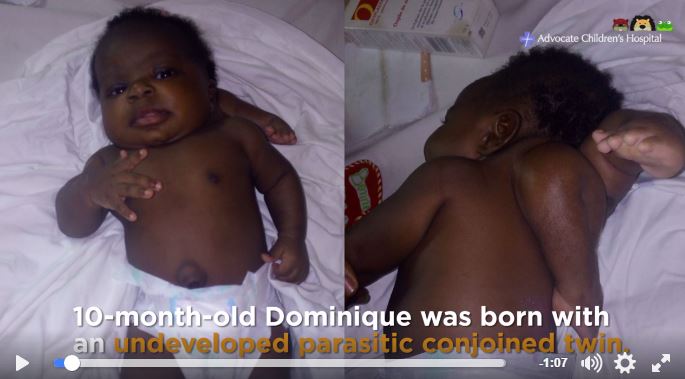Infant's Rare 'Parasitic Twin' Successfully Removed with Surgery

A 10-month-old girl who was born with a rare "parasitic twin" attached to her body has undergone a successful surgery to separate her from this underdeveloped twin.
The infant, named Dominique, was born with the lower half of her twin's body — including legs and feet — protruding from her upper back and neck, according to information released from Advocate Children's Hospital in Park Ridge, Illinois, the facility where the surgery was performed. To receive the medical care she needed, she traveled from her home in Ivory Coast, a country in West Africa, to the United States. During a 6-hour operation on March 8, a team at Advocate Children's Hospital successfully removed the parasitic twin without any complications. [Seeing Double: 8 Fascinating Facts About Twins]
"She's doing really well," Nancy Swabb, who provided foster care to Dominique while she was in the United States, said at a press conference today (March 21), which was broadcast on Facebook Live. Swabb also noted that Dominique appeared to be raising her hands slightly more than before her surgery, and weighs about 2 lbs. less.
In cases of parasitic twins, a baby is born largely intact, but that baby also contains the tissues of an underdeveloped twin (the "parasitic twin") who died during development in the womb. The tissues of the parasitic twin are dependent upon the body systems of the "host" twin, according to a 2010 review paper on parasitic twins.
"Dominique provided all the support for this partially formed twin," said Dr. John Ruge, a pediatric neurosurgeon at Advocate Children's Hospital who was part of Dominique's surgical team. Parasitic twins are very rare, occurring at the rate of about 1 in 1 million live births, according to the 2010 review.
The condition occurs when identical twins fail to separate, Ruge said. Exactly why this happens isn't known, but one hypothesis is that there is a restriction of blood supply in the womb during pregnancy, which causes the death and partial resorption of one of the twins, according to a 2008 paper on a different parasitic twin case.
Without surgery, Dominique was at high risk of paralysis from her condition because the parasitic twin's tissues were attached to her spine, which made Dominique vulnerable to pressure and pulling on her spinal cord, Ruge said. Dominique's condition was also risky because her heart and lungs had to do extra work to provide for two people, Ruge said, which could have shortened her life span.
Sign up for the Live Science daily newsletter now
Get the world’s most fascinating discoveries delivered straight to your inbox.
Dominique will soon be reunited with her family in Africa, according to Advocate Children's Hospital.
Original article on Live Science.

Rachael is a Live Science contributor, and was a former channel editor and senior writer for Live Science between 2010 and 2022. She has a master's degree in journalism from New York University's Science, Health and Environmental Reporting Program. She also holds a B.S. in molecular biology and an M.S. in biology from the University of California, San Diego. Her work has appeared in Scienceline, The Washington Post and Scientific American.











